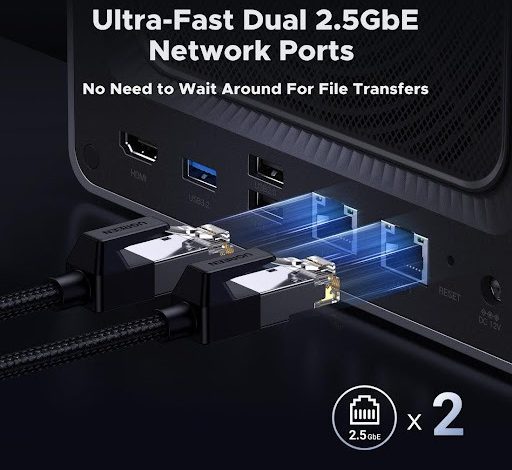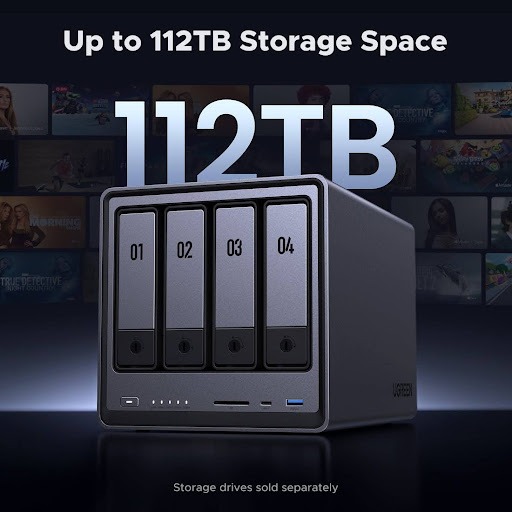What Makes a 4-Bay NAS Essential for Home Storage Solutions?

In a world where individuals are generating more personal data than ever before, the days of personal data storage are becoming more challenging for users at home. Traditional storage solutions like external hard drives and cloud services often come short of meeting comprehensive data management needs for the ever-growing digital content from precious family photos and high-resolution 4K videos to important documents and media collections. But tech-minded home users who need reliable, secure, and scalable solutions have turned to network network-attached storage (NAS) systems, and 4-bay NAS systems are now the gold standard. Meanwhile, modern NAS, as seen here with this UGREEN NASync, uses advanced features like RAID protection to keep data healthy while enabling access across multiple devices. This guide discusses why for most home users a 4-bay NAS is the ideal balance of capacity, redundancy and functionality, to future-proof your digital storage needs and keep full confidence in control of your own data.
Understanding the Functionality of a 4-Bay NAS System
A NAS (network attached storage) system acts as your little data center — it connects directly to your home network to offer centralized storage that all your devices can access. The 4-bay setup is really the sweet spot for home users, with plenty of storage while being relatively smaller. Each bay can take a standard hard drive or SSD, so you can start small and gradually grow storage. Its fortified processor and RAM collaborate in controlling file transfers, user access, and higher-end functionalities like media streaming.
The benefits of a 4-bay NAS come in when we look at its practical application. Photographers can automatically back up their photos as well as keep them accessible for editing. Digital enthusiasts can stream their media libraries to multiple TVs simultaneously. Remote workers access business files securely from anywhere, and families share and protect precious memories across generations. With multiple drive bays, RAID configurations can also be used for greater data protection, which means data can survive a drive failure.

Modern 4-bay systems also function as application servers, running services like surveillance systems, personal cloud storage, and even virtual machines. This expandability, combined with robust data protection and network accessibility, makes a 4-bay NAS an essential foundation for any sophisticated home storage strategy.
Comparing Storage Options: 4-Bay NAS vs. Alternatives
Conventional storage solutions such as cloud storage and external drives have serious limitations when it comes to performance. The subscription fees for cloud storage services scale with actual data use—and they risk violating privacy, as data isn’t controlled by the user on a pre-existing service, but is handled through a series of external individuals or groups. External hard drives are cheap in the beginning, but there isn’t any redundancy built into them and since they aren’t network accessible, sharing files and access to them remotely is very cumbersome.
Why 4-Bay NAS Outperforms Single-Drive Solutions
Advanced RAID configurations allow a 4-bay NAS system to completely change home storage functionality. Unlike simple single-drive solutions, RAID arrays strip the data across multiple drives to allow for read/write access to multiple drives at the same time, improving the overall performance. A RAID 5 configuration across four drives, for instance, yields better speed and data protection, which allows the system to keep functioning even if one drive goes on the fritz. For example, with current drive sizes of up to 20TB per bay, only a 4-bay NAS can deliver 60TB of protected storage space, which is up to 12 times larger than typical external drives while retaining data safety with data redundancy. Putting this all together, the 4-bay NAS system is the ideal, most cost-effective long-term investment for serious home storage requirements as it marries all the technologies available for massive storage potential, data protection, and network accessibility.
RAID Protection in 4-Bay NAS: Safeguarding Your Data
RAID technology is at the heart of ensuring data redundancy in 4-bay NAS systems, with various RAID configurations available to meet diverse requirements. RAID 0 spreads data out across drives for maximum performance but no redundancy whatsoever. RAID 1 does mirroring within drive pairs, thus protecting from a single active failure, but at the cost of half the total capacity. RAID 5 is the perfect balance of minimum three drive requirement, along with single drive failure protection. RAID 10 is a hybrid of mirroring and striping that provides the best performance and redundancy, typically used with critical data.
The process for setting up RAID on your 4-bay NAS will begin by installing compatible drives and accessing the RAID configuration utility. Choose your RAID level according to your needs; RAID 5 is ideal for most average home users, with 75% usable capacity and single-drive failure protection. The system will be busy initializing the array, a process which can take several hours depending on the size of the drives included. After the initial configuration, your NAS takes care of the RAID array, keeping track of drive health and notifying you of possible problems.
In the event of a drive failure, modern NAS devices issue immediate alerts. Replace the failed drive, and the array is automatically rebuilt using redundant data. To ensure maximum protection, always have a backup drive to hand and set up scheduled SMART checks for drive health. This helps keep your data safe even when hardware eventually fails.
Choosing the Right 4-Bay NAS: A Buyer’s Guide
If you are planning on picking the right NAS system that will be 4 bays, first calculate how much storage you will need over the next 3-5 years. Consider the volume of data you currently have, as well as growth from photos, videos, and backups. For most home users, adding 2-3TB of growth each year should leave you with plenty of room. The processor and RAM, for example, will directly affect performance — a quad-core CPU and 4GB RAM minimum should keep multiple simultaneous users and media transcoding happy.
Real-world performance is greatly impacted by the network connectivity options. Although all NAS units provide Gigabit Ethernet, some models support link aggregation, allowing for double network speeds when the need arises. Some higher-end units even have 2.5GbE or 10GbE ports to future-proof your purchase as network speed increases. USB ports allow for connectivity for external drives for backup or expansion.
For the best in flexibility, look for a NAS that supports both 3.5in and 2.5in drives, letting you mix HDDs and SSDs. Be aware of the maximum supported drive capacity – leading NAS systems now support 20TB+ drives. If you narrow your list down to a few candidates, assess the software features available, especially backup tools, media servers, and mobile apps. A smartly designed user interface makes it very easy to manage the tasks. Lastly, check how the manufacturer handles firmware and security patches and whether they offer long-term support for their products.
Summary of 4-Bay NAS Benefits
An essential asset for modern home storage needs, a 4-bay NAS system combines flexibility, security and accessibility like none other. These systems safeguard irreplaceable data, with advanced RAID configurations and expandable storage and give seamless access across all devices. The UGREEN NASync is an example of how modern NAS solutions offer enterprise-level features with home-friendly interfaces — giving even the home user everything they need to manage advanced storage. A 4-bay NAS offers incredible value for families wanting to preserve their digital legacy, creative professionals needing dependable workflow solutions, or tech fans wanting a scalable home server platform. A well-designed system with high-performance hardware specifications will ensure optimal performance, and with manufacturers releasing firmware updates on a regular basis, users can be sure that their storage solution will be future-proofed for many years to come, resulting in control of valuable data without it being compromised. Mine are used, and 4-bay NAS are available at various prices and capacities.





